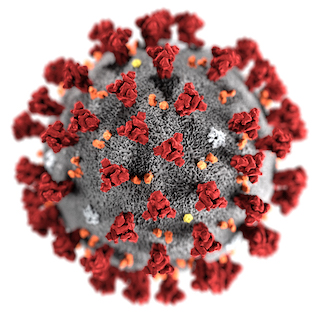Targets
Drug targeting modalities for COVID-19 drug discovery
Data classification:- Targets: The biological mechanisms and functions which can be exploited to reduce, prevent, or treat the virus.
- Proteins: The biological proteins associated with the SARS-CoV-2 virus and host.
- Therapeutics: Molecules, drugs, antibodies, peptides, etc. which implement targets.
3CLpro / Mpro activity
3CLpro (main protease, M-PRO, etc) is a viral cysteine protease responsible for maturation of the viral polyprotein, necessary for infection. It is the target of many drug discovery campaigns. 3CLpro is an obligate dimer, although many drug design efforts just use a monomer structure. Two potential therapeutic modalities exist, the first being active site inhibition, and the second being dimerization inhibition.
Proteins affected: 3CLpro
Potential therapeutic modalities: Small Molecule
Inhibition of PLpro protease activity
PLpro (NSP3, papain-like protease) is a viral cysteine protease responsible for maturation of the viral polyprotein, necessary for infection. Also involved in repressing host immune response.
Proteins affected: PLpro
Potential therapeutic modalities: Small Molecule
Host immune response
Certain mechanisms allow viruses to avoid host immune response, such as removal of ISG15, a ubiquitin-like protein conjugated to intracellular proteins post interferon activation and involved in cell-to-cell signaling and heightened immune response. Removal of such tags and disruption of signal cascades allow infected cells to avoid apoptotic signals.
Proteins affected: IL6R
Potential therapeutic modalities: Antibody
Key publications:
- Potential Treatments for COVID-19; a Narrative Literature Review [PubMed]
- Molecular immune pathogenesis and diagnosis of COVID-19 [DOI]
Inhibition of nsp13 helicase activity
Nsp13, nonstructural protein 13 has multiple functions with an N-terminal metal binding domain (MBD) and a helicase domain (Hel). The nsp13 SARS sequence is conserved and helicase activity is necessary for COVID replication. While this is an attractive target for viral inhibition, there are few reports on nsp13 inhibitors. Helicase inhibition has been used for virus (HSV-amenavir) and cancer treatment (eIF41, RocA rocaglamides), but likely due to its inherent flexibility, inhibitor design is challenging and high throughput screen hits are generally DNA binding artifacts.
Proteins affected: Helicase
Potential therapeutic modalities: Small Molecule
Key publications:
- Analysis of therapeutic targets for SARS-CoV-2 and discovery of potential drugs by computational methods [DOI]
- Novel Inhibitors of Severe Acute Respiratory Syndrome Coronavirus Entry That Act by Three Distinct Mechanisms [DOI]
Blocking SARS-CoV-2 Spike protein binding to human ACE2 receptor
The spike protein of SARS-CoV-2 binds to the ACE2 protein to initiate cell entry.
Proteins affected: ACE2 RBD
Potential therapeutic modalities: Antibody Small Molecule Vaccine
Inhibiting cleavage of the SARS-CoV-2 spike protein
Proteins such as TMPRSS2 cleave the spike protein, enabling the release of S1 and the reorganization of S2 to make the fusion core
Proteins affected: spike TMPRSS2
Potential therapeutic modalities: Antibody Small Molecule
Inhibition of formation of the viral fusion core
After the S1 subunit is cleaved from the spike protein, S2 rearranges itself, bringing two heptad repeats in close, stable proximity to form a 6 helical coiled coil known as the fusion core. The formation of the fusion core is thought to drive viral-host membrane fusion, and inhibiting its formation could halt viral entry.
Proteins affected: fusion core
Key publications:
- Fusion mechanism of 2019-nCoV and fusion inhibitors targeting HR1 domain in spike protein [DOI]
- Biochemical analysis of coronavirus spike glycoprotein conformational intermediates during membrane fusion [DOI]
Inhibition of viral polymerases
Inhibition of viral replication via inhibition of NSP7, NSP8, and RdRp is a feasible route to therapy.